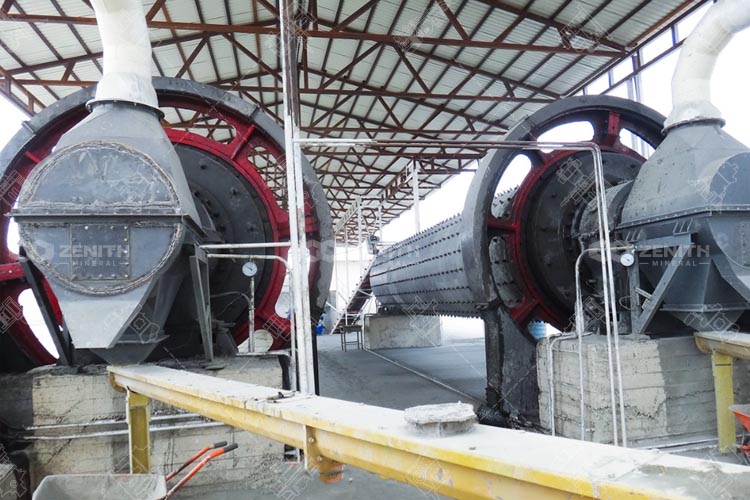In the clay processing plant, clay grinding mill plays an important role. A clay grinding mill is a machine that converts chunks of clay or raw clay into fine powder, which can be further used in a variety of applications. Clay grinding is a necessary step in the clay processing flow, primarily for producing a fine-powdered clay suitable for forming into various products.

When selecting a clay grinding mill, factors like the desired fineness, production capacity, energy consumption, and cost should be considered. It's important to choose a mill that suits your specific requirements and application.
Here are some commonly used clay grinding mills:
Ball mill for clay grinding
Ball mill is a common piece of equipment in the world of industrial grinding, and it's a versatile tool that's used for grinding materials into very fine particles. When it comes to clay processing and clay grinding, the ball mill is a reliable choice.

Ball mill consists of a hollow cylindrical shell that rotates around its axis. Inside the shell, you'd find hard balls – typically made of steel, ceramic, or sometimes rubber. As the shell rotates, these balls move, creating an impact and friction force on the material (in this case, clay) which gradually grinds it down to the desired consistency.
Key Features:
- 1. Adaptability: Ball mills can grind various ores and other materials either wet or dry, depending on requirements. With clay, it's common to see both dry and wet grinding.
- 2. Particle Size: Using different-sized grinding media and adjusting the machine parameters, you can produce varying particle sizes.
- 3. Versatility: Ball mills can be used for not just clay but a wide range of materials.
- 4. Scalability: From lab-scale to industrial production, ball mills can be found in various sizes.
Raymond mill for clay grinding
The Raymond Mill is a commonly used equipment for grinding materials, especially non-metallic ores like clay, limestone, and others. It's popularly used because of its efficient grinding mechanism and simplicity.
Raymond Mill, sometimes known as a pendulum mill, features a vertical structure. The material is fed into the machine from the top and falls into the grinding roller and grinding ring. Under the action of centrifugal force, the roller rolls outward and achieves grinding between the grinding roller and grinding ring. The ground powder then flows with the airflow into the separator for separation, with coarser particles falling back for regrinding.
Key Features:
- 1. Efficiency: It is energy-efficient and has a small footprint, making it a popular choice for modern industrial applications.
- 2. Particle Size Control: The fineness of the end product can be adjusted between a wide range, typically from 50 to 325 mesh.
- 3. Durability: Given its robust build, Raymond Mill tends to have a long operational life with minimal maintenance.
Ultrafine vertical mill
An ultrafine vertical mill is a type of grinding mill that is specifically designed for producing ultrafine powders or particles. It is commonly used in various industries for grinding materials with high hardness and fineness requirements, including clay.

The ultrafine vertical mill typically consists of a vertical grinding chamber or mill body that contains a rotating grinding disc. The grinding disc is equipped with grinding rollers or blades that exert pressure on the material, causing it to be crushed and ground into ultrafine particles.
Key Features:
- 1. High fineness: The mill is capable of producing extremely fine clay powders or particles with a narrow particle size distribution. This allows for precise control over the fineness of the final product.
- 2. Efficient grinding: The vertical design of the mill enables efficient grinding due to the gravitational force acting on the material. It helps in achieving higher grinding efficiency compared to other types of mills.
- 3. Low energy consumption: Ultrafine vertical mills are designed to minimize energy consumption while delivering high-performance grinding. This can result in cost savings and environmental benefits.
- 4. Space-saving design: The vertical orientation of the mill allows for a compact footprint, making it suitable for installations with limited space.
Benefits of Using a Clay Grinding Mill
- 1. Uniform Particle Size: Grinding ensures a consistent particle size, which is crucial for the subsequent applications.
- 2. Increased Surface Area: Fine grinding increases the surface area of the clay particles, which can enhance their binding properties in certain applications.
- 3. Improved Product Quality: Uniformly ground particles lead to better quality products when the clay is used in production.
- 4. Enhanced Reactivity: For applications where the clay is used as a reactant, finer particles can often react more readily.
Factors to Consider When Choosing a Clay Grinding Mill
Choosing the right grinding mill for clay processing is crucial to ensure optimal results, efficient production, and cost-effectiveness. Here are the key factors to consider:
- 1. Particle Size Requirement: Different mills can achieve different fineness levels. It's essential to understand the required particle size for your end product.
- 2. Throughput Capacity: If you have a high production volume, ensure the chosen mill can handle the desired capacity.
- 3. Physical Footprint: Ensure you have enough space in your facility for the mill, considering its dimensions and auxiliary equipment.
- 4. Budget Constraints: The initial cost of the mill, installation, and any necessary auxiliary equipment should fit within your budget.
- 5. Vendor Reputation: Opt for manufacturers known for quality, reliability, and excellent customer support.
- 6. Environmental Impact: Some mills might have a lower environmental impact due to reduced energy consumption, waste production, or other factors.
- 7. Operational Safety: Safety features, easy access for cleaning, and other safety considerations are crucial, especially in large-scale operations.
- 8. Training and Support: Consider the level of training and post-sales support provided by the manufacturer.



